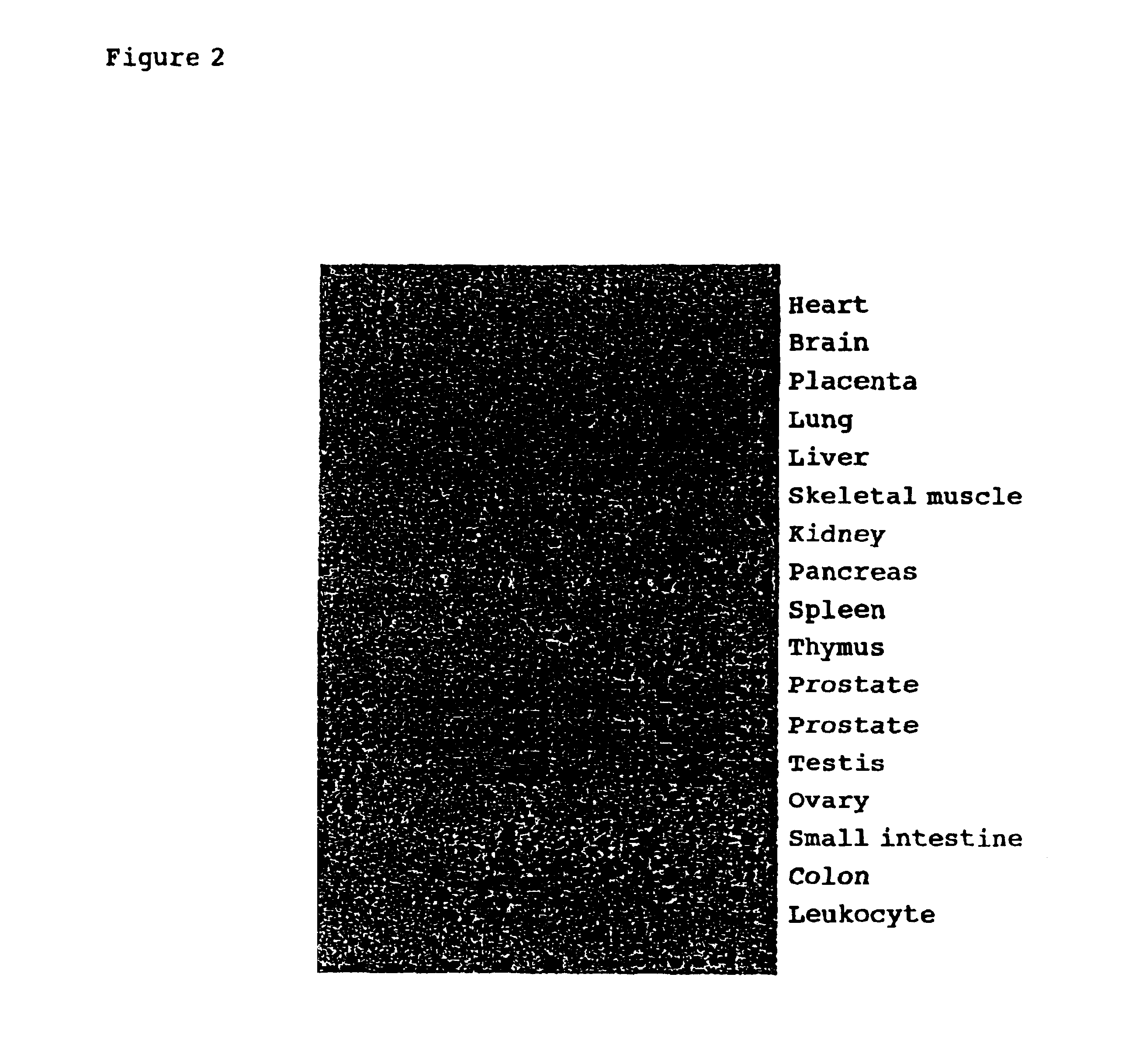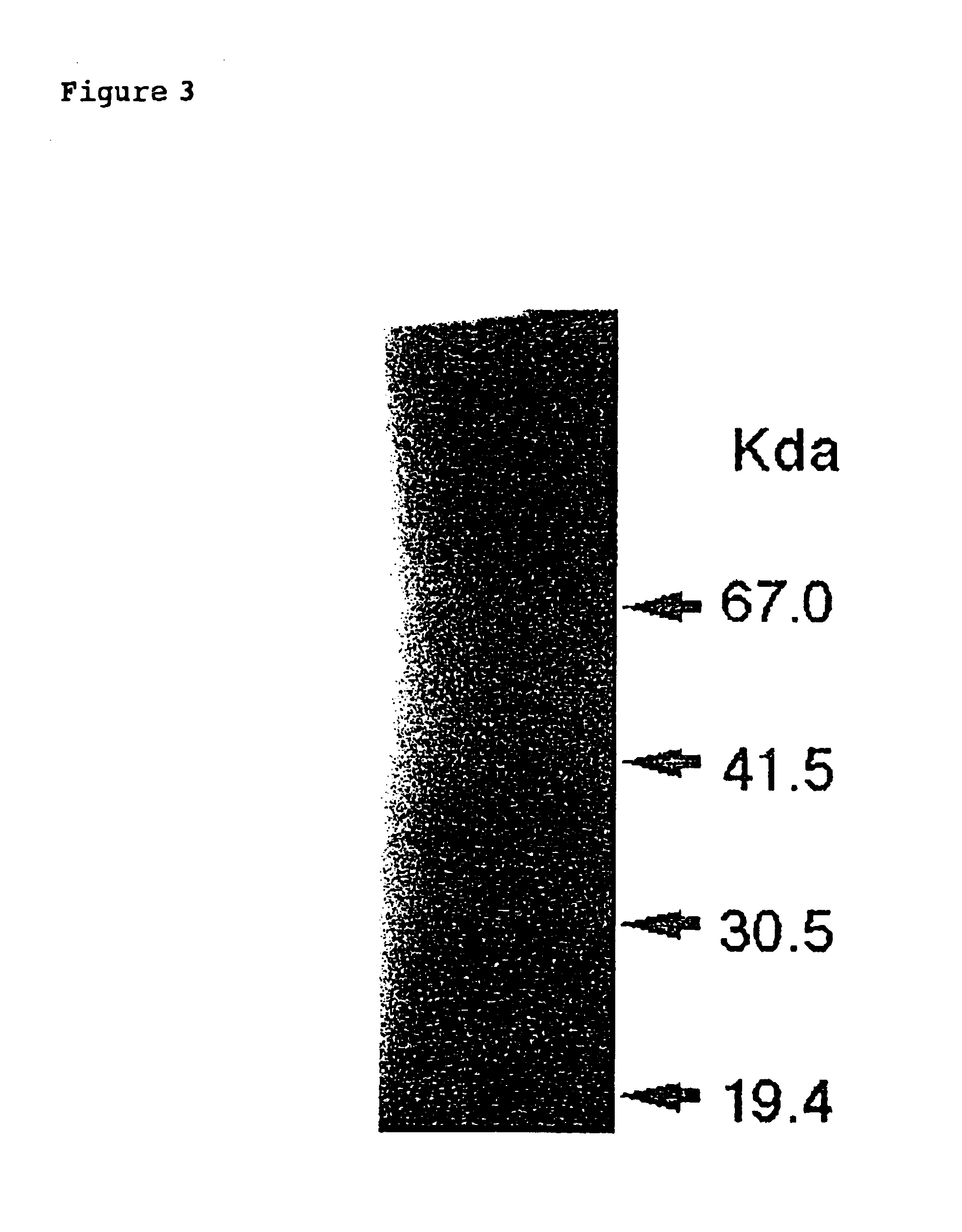Testis-specific differentiation-regulatory factor
a differentiation-regulatory factor and testis technology, applied in the field of bioscience, can solve the problem of little known about the biological and physical roles of their gene products
- Summary
- Abstract
- Description
- Claims
- Application Information
AI Technical Summary
Benefits of technology
Problems solved by technology
Method used
Image
Examples
example 1
Isolation of Tesmin Gene Fragment Using RT-PCR
[0056]The expression of the novel substance WF-1 (a function-unknown novel gene comprising 1700 bp) in each organ was analyzed by the RT-PCR method. Specifically, total RNA was extracted from the brain, liver, spleen, kidney, heart, and testis of ICR strain mice (Clea Japan) using ISOGEN (NIPPON GENE). After denaturing RNA at 65° C., cDNA was prepared using reverse transcriptase: superscript 2 (GIBCO BRL). Using cDNA from each organ, and the oligo primers for WF-1 amplification described in SEQ ID NOs: 6 and 7, PCR reaction was conducted for 32 cycles of 94° C. for 1 min, 58° C. for 2 min, and 72° C. for 3 min. The control GAPDH was amplified by PCR using the oligo primers described in SEQ ID NOs: 8 and 9 under the condition of 30 cycles of 94° C. for 1 min, 58° C. for 2 min, and 72° C. for 3 min. As a result, a gene specifically expressed only in the testis was unexpectedly found through a detection using oligo primers for WF-1 amplific...
example 2
Cloning and Sequencing of Mouse Tesmin cDNA
[0057]The sequence of the above cDNA fragment was determined by the dideoxy chain termination method and analyzed by the ABI377 auto sequencer. As a result of a database search for the determined sequence, this sequence was revealed to be a novel gene that did not have a homology to genes in the databank. This cDNA fragment was 32P radio-labeled to prepare a probe, and using this, a mouse testis library was screened. As a result, a clone having an approximately 1.7 kb length was obtained.
[0058]Moreover, 5′-RACE was conducted to determine the 5′ end sequence. In 5′-RACE, three antisense primers specific to the Tesmin gene, namely, SP1 (SEQ ID NO: 10), SP2 (SEQ ID NO: 11), and SP3 (SEQ ID NO: 12), and mouse testis-derived 5′-Marathon RACE cDNA were used. The 5′-RACE method was conducted following the protocol provided in the Marathon-Ready™ cDNA kit (mouse testis), which is commercially available from Clontech. The whole nucleotide sequence o...
example 3
Cloning and Sequencing of Human Tesmin cDNA
[0060]Mouse Tesmin plasmid (a plasmid in which the Tesmin gene has been inserted into the pBluescript2 vector) was cleaved by SphI-Sa1I, and this 1.7 kb gene fragment was used as a probe to screen the cDNA library prepared by human testis MRNA. Hybridization was done using the “Rapid-hyb buffer” (Amersham LIFE SCIENCE) under the following conditions: (i) a prehybridization at 60° C. for 30 min, (ii) addition of the labeled probe, and (iii) hybridization by incubating at 60° C. for 2 hr. After that, washing is done three times within 2×SSC, 0.01% SDS for 20 min at room temperature, and next, three times within 1×SSC, 0.1% SDS, at 37° C. for 20 min, followed by, two times within 1×SSC, 0.1% SDS, at 50° C. for 20 min.
[0061]The nucleotide sequence of thus obtained human Tesmin cDNA is shown in SEQ ID NO: 3. Database search for the determined nucleotide sequence was done but there were no homologous sequences within the databank, similar to the ...
PUM
| Property | Measurement | Unit |
|---|---|---|
| temperature | aaaaa | aaaaa |
| temperature | aaaaa | aaaaa |
| temperature | aaaaa | aaaaa |
Abstract
Description
Claims
Application Information
 Login to View More
Login to View More - R&D
- Intellectual Property
- Life Sciences
- Materials
- Tech Scout
- Unparalleled Data Quality
- Higher Quality Content
- 60% Fewer Hallucinations
Browse by: Latest US Patents, China's latest patents, Technical Efficacy Thesaurus, Application Domain, Technology Topic, Popular Technical Reports.
© 2025 PatSnap. All rights reserved.Legal|Privacy policy|Modern Slavery Act Transparency Statement|Sitemap|About US| Contact US: help@patsnap.com



